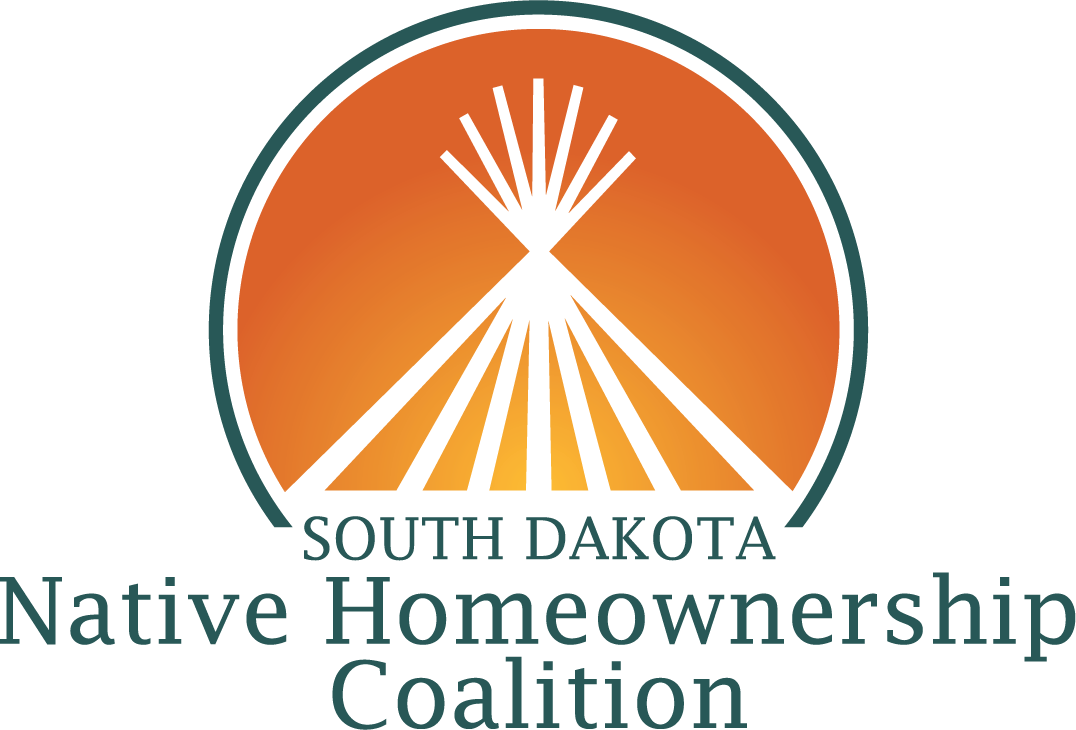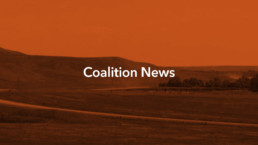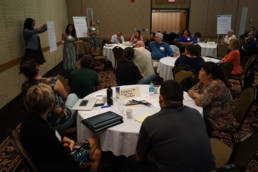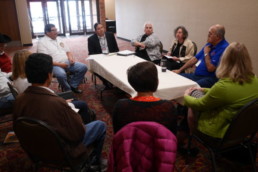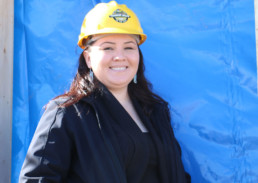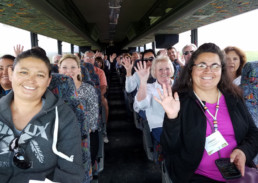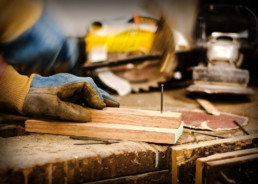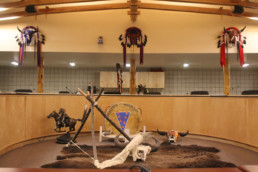Coalition Members Learn How to Integrate Coaching into Homebuyer Readiness Programs
In November, 17 practitioners in the Native homeownership field completed a three-day training where they learned about new financial coaching methods to integrate into their programs. The training, hosted by the Coalition and co-facilitated by CNM Ingenuity and Seven Sisters Community Development Group, focused on a coaching model that is designed to empower clients. Different from the traditional case management model where practitioners advise clients, coaching asks powerful questions so that the client can identify their own goals and create their own path to attain those goals.
“This approach reminds me of how our elders talk to us. They allow silence and reflection so you know what you need to do,” says Vickie Oldman John of Seven Sisters who helped facilitate the training.
Training participants learned how to avoid reacting to crises along with several important components of coaching, such as whole body listening and personal self-talk. They also participated in several interactive exercises where they were able to put their new skills to the test.
“Learning the tools to be a financial coach has been an exciting process. It forces you to think outside the box to come up with creative questions,” says Kimberly Claymore from Cheyenne River Housing Authority.
The training also included a segment on how to integrate the coaching model into an organizational culture. This segment allowed participants to brainstorm ideas and develop plans on how to use this new method in their work with clients.
“Financial coaching is something I’ve been interested in since I began my job as an Individual Development Account coach. I plan to put my financial coaching training to immediate use,” said Elaine MatoTama Hece from the Oglala Sioux Tribe Partnership for Housing on Pine Ridge.
The financial coaching training was inspired out of a need expressed by the Coalition’s Homebuyer Readiness Committee who established it as a milestone to complete in 2017. All training participants received text book and a financial calculator.
Tribal Leaders Support Coalition’s Policy Recommendations
At its December meeting, the Great Plains Tribal Chairmen’s Association adopted two resolutions in support of the South Dakota Native Homeownership Coaltion’s policy recommendations to federal policymakers.
The first resolution supported legislative amendments to the US Department of Veterans Affairs Native American Direct Loan (NADL) program to improve homeownership opportunities for Native veterans on Indian reservations in South Dakota.
The second resolution supported other broader homeownership recommendations including:
- Support for the implementation of the USDA Rural Development 502 home loan relending pilot
- Funding for the Bureau of Indian Affairs Housing Improvement Program
- Improvements to the HUD Section 184 loan guarantee program to increase deployment on trust land
- Exploring new partnerships with Fannie Mae and Freddie Mac as part of their Duty to Serve implementation plans
The Coalition appreciates the support of Cheyenne River Sioux Tribe Chairman Harold Frazier, who introduced the resolutions. We look forward to continuing to collaborate with the Great Plains Tribal Chairmen’s Association and South Dakota’s tribal leadership and Tribal Veteran Service Officers to promote these policy changes.
Coalition to Launch Round II of Housing Needs Studies
With support from the South Dakota Housing Development Authority, the South Dakota Native Homeownership Coalition (Coalition) will be facilitating housing needs studies (studies) in two small tribal communities in South Dakota. Under the program guidelines, eligible tribal communities must have a population of 10,000 or less. The size of the community/reservation will determine whether one specific community or the broader reservation is assessed. Work to conduct these studies will start by January 1, 2018, and studies will be completed by June 30, 2018.
These studies will play an important role in effective planning for future housing efforts. The study for each community will include the following data elements: existing housing stock, housing issues, homeownership information, information on housing providers and programs, potential barriers to homeownership, demographics, economics, and recommendations.
In facilitating these housing needs studies, the Coalition will identify two tribal communities to be assessed (through an application – see link below). The Coalition will contract with Big Water Consulting, an experienced firm which has conducted prior studies, to carry out the assessments. Big Water Consulting will work closely with the communities to be assessed, and the sponsoring tribal organization must designate at least one staff member to assist the firm in conducting the assessment. It is critical that the sponsoring community dedicate sufficient time and attention to working with Big Water Consulting.
The total budget for each study will not exceed $20,000 per study. Support from the Coalition (provided by the South Dakota Housing Development Authority) will cover 50% of the cost of each study, for a maximum of $10,000 per study. Each selected community will be required to pay a cash match to cover the other half of the cost of its study (up to $10,000). There are no restrictions on the source of match funds; however, match funds must be provided in cash by January 1, 2018. Applicants will be asked to indicate potential sources of match as part of the application process.
Submitting Applications
To apply to participate in the housing needs study, interested communities should complete the following application. Applicants will be evaluated based on current homeownership efforts, involvement in the Coalition, plans to use information collected through the assessment, and ability to provide matching funds.
The application package should contain:
- Completed application form (signed)
- Scanned copy of governing body minutes or resolution authorizing application
Applications should be submitted by November 30, 2017 per the instructions in the application package.
Coalition Continues Growing and Developing
On September 11-13, 2017, over 60 members of the South Dakota Native Homeownership Coalition gathered for our annual planning session and other activities held in conjunction with the South Dakota Housing Development Authority’s Annual Housing Conference in Pierre, South Dakota. The series of events provided a platform for our continued growth and development, as well as peer sharing and networking opportunities.
Coalition Planning Day – September 11, 2017
Attendees of our fourth annual planning day represented our diverse membership, and included Native and non-Native nonprofit organizations, Tribally Designated Housing Entities (TDHEs), tribal departments, federal agencies, state agencies, lenders, and Community Development Financial Institutions (CDFIs).
The day’s full agenda included:
Preview of the Coalition’s “Native Homeownership is Possible” video series
Coalition members had the opportunity to view and provide their feedback on the first two of a series of videos that the Coalition is developing to promote the message that “Native Homeownersip is Possible.” Members’ feedback was very positive about the videos, which are being produced by David Cournoyer of Plain Depth Consulting and Jay Fishback of Northern Voyage Productions. After watching the videos, Coalition members also shared suggestions bout how to launch the videos and what additional materials should accompany them.
Exploration of strategies to promote the Coalition’s long-term sustainability
Recognizing the importance of going beyond foundation support and diversify funding sources, Coalition members explored different potential income generating strategies, including:
- Membership dues
- Registration fees
- Holding a homeownership development summit
- Producing a post-purchase curriculum
- Reaching out to tribes for support
- Creating a development corporation
Information sharing on the appraiser apprenticeship process
Brian Gatzke, an appraiser out of Brookings, SD, shared information about the appraiser apprenticeship process and requirements for certification. Coalition members are excited to work with Brian and other partners to support appraiser candidates, and have formed a special subcommittee of the Physical Issues Committee to focus on this issue. Next steps for this subcommittee include working to identify potential appraisal apprentice candidates and supervisors.
Information sharing on Enterprise Community Partners’ VISTA Program
Enterprise Program Director Vince Gallagher shared information about this program, which can place VISTA volunteers at Coalition member organizations. Please stay tuned for a webinar with more information on program guidelines, what VISTA volunteers can do, and how to request a VISTA volunteer at your organization.
In-person Coalition committee meetings
During the planning session, Coalition members had a chance to hold in-person committee meetings to review progress over the past year, and set 2018 milestones. Select milestones that committees will be focusing on include:
| Committee | Select Milestones |
| Homebuyer Readiness |
|
| Funding and Finance |
|
| Physical Issues |
|
| Veterans |
|
| Policy |
|
Native Homeownership Conference Track – September 12-13, 2017
This year, the Coalition planned and provided the conference’s Native Homeownership Track, with the following workshops:
- Paths to Homeownership for Native Veterans
- Estate Planning for Homeowners
- Sustainable Homeownership Development on Crow Creek
- Beyond Housing: Building Neighborhood Communities
- Preparing a Construction Workforce: the Coalition’s Construction Internship
Featuring topics that are relevant to Coalition members and providing a valuable opportunity to share the work of the Coalition, the workshops were well-attended, generating productive discussions and positive feedback.
Additional Gatherings
This year, the Coalition also facilitated a number of additional gatherings in conjunction with the SDHDA conference:
- Breakfast to explore increased lender participation in the Federal Home Loan Bank’s Native American Homeownership Initiative (NAHI)
- Homebuyer practitioner gathering focused on data collection
- Post-conference debriefing session
At the post-conference debriefing session, participants shared what they were most excited about the conference and the coming year. Responses included:
- Starting to focus on estate planning, wills and successorship
- Veterans’ programming and the CDFI/NADL model
- Appraiser initiative
- Looking at community engagement
- Focusing on the 502 re-lending pilot program
Please share your input about the Coalition!
We are seeking feedback from all stakeholders about how valuable the Coalition is to you and your organization. Please click on the link below to complete a brief survey by Friday, September 1, 2017.
Chance for FREE Conference Registration!
All survey respondents who complete the survey by 5 pm MT on September 1 will be entered into a drawing to win a free registration to the annual South Dakota Housing Conference on September 11 – 13, 2017. A $200 value!
Thank you for sharing your perspective! We will share results at the Coalition’s planning meeting on September 11, 2017 in Pierre.
Building a Foundation for Homeownership in Indian Country
While homeownership in general has been on a decline across the United States, it is increasing on reservations in South Dakota. More tribes are recognizing the capacity for homeownership to build individual and community wealth, wellness, and stability, thanks in large part to individuals from tribal communities who have become strong homeownership advocates. Homeownership advocates Sharon Vogel and JC Crawford, for example have both worked tirelessly in their respective communities to tackle the unique obstacles related to becoming a homeowner on their reservations, and others are taking notice.
Government policies that dismantled traditional ways of living in tribal communities have created a housing system that largely keeps people in a system of life-long renting, preventing families from building their personal equity and assets. As tribal communities begin to revitalize and empower themselves economically, government prescribed housing options are continuing to fall short of what many tribal housing authorities see as necessary to adequately serve their communities. Families of various income levels often compete for the same housing since a limited housing stock is available.
“The thing about housing on reservations is we focus so much on low income housing, which is necessary” says Elsie Meeks, former USDA – Rural Development State Director in South Dakota. “But we’ve also filled up a lot of houses that could have gone to low income families with people that could afford to buy homes and benefit from homeownership.”
Sharon Vogel, Executive Director of the Cheyenne River Housing Authority, sees homeownership as a strategic tool for strengthening tribal communities. Her work helps families have a comprehensive understanding of the complex process of Native homeownership and their options in accomplishing homeownership. “There are far reaching impacts of homeownership that go beyond financial benefits,” says Vogel. “Homeownership really puts families in control. People can decide everything from the location of their home to the design of it, making sure the home meets their family’s needs. Research shows that children who grow up in a family home that is owned have better outcomes in school.”
On the Sisseton Wahpeton reservation in South Dakota, Housing Authority Executive Director and homeownership advocate James “JC” Crawford also works to co-create a more successful housing system for his tribe. For instance, to address the issue of banks that were hesitant to lend in Native communities, Sisseton Wahpeton created a “risk pool” that would enable the tribe to purchase any home potentially in foreclosure, and resell the home to another tribal member. By thinking ahead, JC helped put lenders at ease and helped ensure that potential homeowners have the opportunity to build their future through homeownership.
“In Indian Country the nature of things is that ‘homeownership isn’t for us’ is a common mentality,” says Crawford, “but I think when we are looking at how we create self-sufficiency in our tribes, we are using our sovereignty to move out of the cycle of renting and into building our equity through homeownership.”
Traveling a Path to Self-Sufficiency
January Mathis Works Toward Homeownership
After a nearly five-year journey, January Mathis, a member of the Oglala Sioux Tribe, will soon be moving into a home she can call her own. January’s home is currently one of seven under construction in Thunder Valley Community Development Corporation’s regenerative community just outside of Porcupine, South Dakota, on the Pine Ridge Reservation. When complete, the community will feature 21 energy efficient homes and meet critical housing needs for local families.
With an estimated 4,000 additional units needed to provide adequate housing for the families on the Pine Ridge Reservation, the development will only slightly alleviate the housing shortage on the Reservation. However, nonprofit organizations like Thunder Valley and Lakota Funds are key players in creating models and providing solutions.
Both organizations are active participants in the South Dakota Native Homeownership Coalition, and are just a few of the many stakeholders that are forming collaborative partnerships to increase homeownership opportunities for Native Americans throughout the state. In January’s case, both Lakota Funds and Thunder Valley are providing critical pieces of the puzzle to make homeownership possible.
January began her homeownership journey in 2012 when she started working with Lakota Funds. She started out by utilizing a Credit Builder Loan to pay off debt and improve her credit score. During this time, she completed various trainings offered by Lakota Funds and built her financial skills so she could successfully create and stick to a budget and responsibly use credit.
In the summer of 2015, January enrolled in Lakota Funds’ Individual Development Account (IDA) program to start saving for a down payment on a home. She began making regular deposits into her savings account at the Lakota Federal Credit Union. For every dollar she deposited, Lakota Funds provided a $3 match. While she was saving, January completed a homeownership preparedness course offered by Thunder Valley. Thunder Valley also helped her through the USDA home loan application process.
By the end of 2016, January had deposited $1,440 into her IDA, and Lakota Funds provided a match of $4,320. When she signed the papers for her new home, January was able to put $5,760 down!
Due to limited options, January currently lives in low-income rental housing in Pine Ridge, South Dakota, about an hour’s drive away from her place of employment—the Pine Ridge Area Chamber of Commerce in Kyle. She is excited that her new home will only be a 10-15 minute drive to work. But homeownership means more to her than that.
“When I think of my own home, the first thing I think of is freedom,” she says. It also means stability, she adds. January explains that she moved quite a bit when her kids were younger, but this home will always be “a place for my kids to call their own.”
Homeownership Models Shared During Annual Convening
The Coalition’s Annual Tour & Convening, hosted on the Pine Ridge Reservation this year, uses a peer-sharing model to showcase successful homeownership programs. This year’s event was attended by approximately 50 individuals from nonprofit organizations as well as tribal, local, state, and federal entities, including Joyce Allen, Deputy Administrator for Single Family Housing of USDA Rural Development. Homeownership models shared on the tour included the following examples:
- A subdivision built in the 1990’s utilizing Low Income Housing Tax Credits, which is now being converted to privately-owned homes.
- The construction of “tiny homes” adjacent to other homes to help alleviate overcrowding.
- A case study of a veteran who was previously living in a veteran’s homeless shelter, moved on to subsidized housing, and then to homeownership.
- The new construction internship program at Oglala Lakota College, designed to help increase the construction workforce and available housing stock.
- The Self-Help Housing development currently under construction at Thunder Valley Community Development Corporation’s regenerative community.
“The Coalition’s collaborative approach has been highly successful so far. It gives stakeholders a hands-on opportunity to build knowledge, bring it back home, and then apply it in our own communities,” says says Tawney Brunch, a member of the Coalition’s Executive Committee.
She adds, “Many of the homeownership practitioners who have attended Coalition events are inspired. Homeownership is a long-term effort, and events like this give us fuel to keep going.”
In support of National Homeownership Month, the Oglala Sioux Tribe presented its Proclamation of Oglala Nation Homeownership Month, acknowledging the many benefits of homeownership and its commitment to support strategies that increase homeownership for its tribal members. The announcement kicked off the South Dakota Native Homeownership Coalition’s Annual Tour & Convening, which explored several innovative pathways to homeownership currently underway on the Pine Ridge Reservation.
“We are grateful to have this support from President Weston. It is a meaningful statement that will help raise awareness of the importance in helping families toward homeownership,” says Brunch.
Coalition Responds to Contractors’ Input
In roundtable discussions with contractors about how to increase housing stock on South Dakota’s reservations, contractors have shared some of the obstacles to residential building, including the lack of inspectors and work-ready employees. In response, our Physical Issues Committee is working to support efforts to increase the number of certified inspectors, and designing a summer internship program for building trades students at Oglala Lakota College to work directly with contractors.
In January, the Coalition held a two-day training to support contractors, TDHE staff, and other nonprofit housing staff in preparing for the inspector certification exam. Thirty seven participants completed this training, and will be taking the certification exam. We wish them luck!
Through the construction internship pilot program, up to twenty students from Oglala Lakota College will spend ten weeks this summer working directly with contractors on the Pine Ridge and Cheyenne River Reservations. The internship will provide the opportunity for students to develop relationships with contractors (leading to potential employment in the future), and gain hands-on work experience. The program will also incorporate financial education and workforce readiness training for students.
Sisseton Wahpeton Oyate Housing Authority Secures Victory Through Advocacy!
Through a persistent effort, the Sisseton Wahpeton Oyate Housing Authority has secured an important tax victory which will result in more affordable mortgages for tribal members. Through this effort, individual home buyers constructing their homes have been granted a sales tax exemption for “Indian Use Only Projects,” which means that they will not have to pay sales tax on materials used to build their homes on trust land. According to JC Crawford, Executive Director of the Sisseton Wahpeton Housing Authority, “eliminating the sales tax makes a real difference for home buyers. At the end of the day, the savings can determine whether or not one of our tribal members can qualify for their mortgage.”
Initial advocacy efforts around the sales tax provision began back in 2012, when five families building in the Long Hollow subdivision filed a request for consideration of the tax exemption – which is one-page, on-line fillable form. When their request was denied, the Sisseton Wahpeton Oyate and their legal group got involved, and the tribal chairman set up a meeting with the Governor. Following this meeting, the decision to deny the exemption request was reversed, and the exemption was granted. Through the exemption process, the contractor building the home on trust land gets a letter indicating that all materials purchased for the home will be exempt from state sales tax.
When a new group of families began home construction in June 2016, the Housing Authority assumed that based on the prior decision, their exemption requests would granted. They were surprised to learn in August 2016 that the requests were denied. The Housing Authority worked with the Sisseton Wahpeton Oyate Tax Office to begin advocacy efforts once again to secure the exemption for tribal families, and in November 2016, a tribal delegation traveled to Pierre to meet with the Secretary of the SD Department of Revenue, Andy Gerlach. In this meeting, the delegation needed to show that the tribe had involvement with families throughout the home construction and buying process. At the meeting, the decision to deny the exemption was reversed, and the exemption was granted.
According to Angie Johnson, Administrator/Counselor of the T Yamni ~ Sisseton Wahpeton Oyate, this policy victory shows the importance of “pushing forward, pushing forward, and not giving up.” She states, “What’s critical here is that we’re saving our homebuyers money. Most are low-income, and we try to save as much as we can on their home – which they’ll have for the rest of their lives.”
